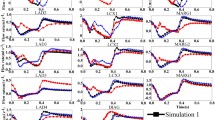Abstract
This study was performed to elucidate the effects of cardiac contraction on coronary pressure-flow relations. On the basis of the waterfall mechanism, a lumped model of the coronary arterial system is presented consisting of a proximal (epicardial) compliance, a coronary resistance, and an intramyocardial compliance. A “back”-pressure, assumed to be proportional (constant k) to left ventricular pressure, impedes flow. From steady-state measurements of circumflex coronary artery flow and inflow pressure, together with left ventricular pressure, the values of the three model parameters and the constant k have been estimated. In the control condition proximal compliance is found to be 1.7×10−12 m4s2kg−1, intramyocardial compliance 110×10−12m4s2kg−1, and resistance 7.5×109kgm−4s−1. The proportionality constant k is close to unity. Effects of changes in left ventricular pressure and inflow pressure and the effect of vasoactive drugs on the parameters are also investigated. Changes in coronary resistance are always opposite to changes in intramyocardial compliance. Sensitivity analysis showed that epicardial compliance plays its major role during isovolumic contraction and relaxation; resistance plays a role throughout the cardiac cycle but is more important in diastole than in systole, whereas intramyocardial compliance plays a role in systole and in early diastole.
Similar content being viewed by others
References
Armour, J.A. and W.C. Randall. Canine left ventricular intramyocardial pressures.Am. J. Physiol. 220:1833–1839, 1971.
Arts, T., R.T.I. Kruger, W. van Gerven, J.A.C. Lambregts, and R.S. Reneman. Propagation velocity and reflection of pressure waves in the canine coronary artery.Am. J. Physiol. 237:H469-H474, 1979.
Bellamy, R.F., Calculation of coronary vascular resistance.Cardiovasc. Res. 14:261–269, 1980.
Brandi, G. and M. McGregor. Intramural pressure in the left ventricle of the dog.Cardiovasc. Res. 3:472–475, 1969.
Burattini, R. and G. Gnudi. Computer identification of models for the arterial tree input impedance: Comparison between two new simple models and first experimental results.Med. Biol. Eng. Comput. 20:134–144, 1982.
Canty, J.M., F.J. Klocke, and R.E. Mates. Coronary capacitance calculated from in vivo measurement of diastolic coronary input impedance.Fed. Proc. 40:1097, 1982.
Canty, J.M., R.E. Mates, and F.J. Klocke. Rapid determination of capacitance-free pressure-flow relationships during single diastoles.Fed. Proc. 42:1092, 1983.
Collatz, L.The Numerical Treatment of Differential Equations. Berlin: Springer-Verlag, 1966, pp. 78–97.
Dole, W.P. and V.S. Bishop. Influence of autoregulation and capacitance on diastolic coronary artery pressure-flow relationships in the dog.Circ. Res. 51:261–270, 1982.
Douglas, J.E. and J.C. Greenfield. Epicardial coronary artery compliance in the dog.Circ. Res. 27:921–929, 1970.
Downey, J.M. and E.S. Kirk. Inhibition of coronary blood flow by a vascular waterfall mechanism.Circ. Res. 36:753–760, 1975.
Downey, J.M. Comments on flow through collapsible tubes at low Reynolds numbers. Letter.Circ. Res. 48:299–301, 1981.
Eng, C. and E.S. Kirk. The arterial component of the coronary capacitance.Circulation 68(Suppl II): [Abstract 1232], 1983.
Hamlin, R.L., M.J. Levesque, and M.D. Kittleson. Intramyocardial pressure and distribution of coronary blood flow during systole and diastole in the horse.Cardiovasc. Res. 16:256–262, 1982.
Johnson, J.R. and J.R. DiPalma. Intramyocardial pressure and its relation to aortic blood pressure.Am. J. Physiol. 125:234–243, 1939.
Kamm, R.D. and A.H. Shapiro. Unsteady flow in a collapsible tube subjected to external pressure or body forces.J. Fluid. Mech. 95:1–78, 1979.
Kirk, E.S. and C.R. Honig. An experimental and theoretical analysis of myocardial tissue pressure.Am. J. Physiol. 207:661–668, 1964.
Lewi, P.J. and W.K.A. Schaper. The estimation of coronary volume elasticity in the beating heart of the dog.Pflügers Arch. 325:191–198, 1971.
Marble, A.E., C.M. McIntyre, R. Hastings-James, and C.W. Hor. A comparison of digital algorithms used in computing the derivative of left ventricular pressure.IEEE Trans. Biomed. Eng. 28:524–529, 1981.
Morgenstern, C., U. Höljes, G. Arnold, and W. Lochner. The influence of coronary pressure and coronary flow on intracoronary blood volume and geometry of the left ventricle.Pflügers Arch. 340:101–111, 1973.
Paulsen, R.A., J.W. Clark Jr., P.H. Murphy and J.A. Burdine. Sensitivity analysis and imposed identification of a systemic arterial model.IEEE Trans. Biomed. Eng. 29:164–177, 1982.
Pedley, T.J.The Fluid Mechanics of Large Blood Vessels. Cambridge: Cambridge University Press, 1980, pp. 301–368.
Permutt, S. and R.I. Riley. Hemodynamics of collapsible vessles with tone: The vascular waterfall.J. Appl. Physiol. 18:924–932, 1963.
Powell, M.J.D. An efficient method for finding the minimum of a function of several variables without calculating derivatives.Computer J. 65:735–740, 1964.
Rabiner, L.R. and B. Gold.Theory and Application of Digital Signal Processing. Englewood Cliffs N.J.: Prentice Hall, 1975, pp. 75–294.
Spaan, J.A.E., N.P.W. Breuls, and J.D. Laird. Diastolic-systolic coronary flow differences are caused by intramyocardial pump action in the anesthetized dog.Circ. Res. 49:584–593, 1981.
Stein, P.D., M. Marzilli, N.S. Hani, and T. Lee. Systolic and diastolic pressure gradients within the left ventricular wall.Am. J. Physiol. 238:H625-H630, 1980.
Westerhof, N., P. Sipkema, and G.A. van Huis. Coronary pressure flow relations and the vascular waterfall.Cardiovasc. Res. 17:162–169, 1983.
Author information
Authors and Affiliations
Rights and permissions
About this article
Cite this article
Burattini, R., Sipkema, P., van Huis, G.A. et al. Identification of canine coronary resistance and intramyocardial compliance on the basis of the waterfall model. Ann Biomed Eng 13, 385–404 (1985). https://doi.org/10.1007/BF02407768
Issue Date:
DOI: https://doi.org/10.1007/BF02407768




